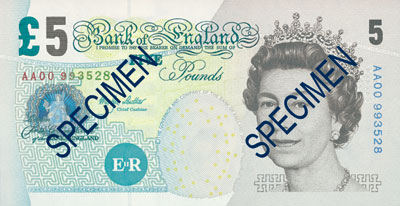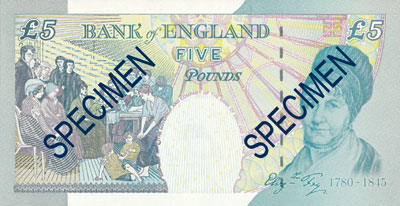As announced in April, the Bank of England's new design �5 banknotes, which feature a portrait of the social reformer, Elizabeth Fry, will be introduced into circulation
today, Tuesday 21 May.
Merlyn Lowther, the Bank's Chief Cashier, whose signature appears on the Bank of England's notes, said "This is the most secure �5 note we have produced. It retains the same colours and size as the existing �5, but with the improved features which were successfully introduced with the new �20 and �10 notes in recent years.
"Anti-counterfeiting and cost effectiveness are the two key objectives of our banknote research work. Where appropriate we incorporate advances in these areas into our ongoing programme of banknote design".
Central to the new �5 note's appearance is the portrait of Elizabeth Fry on the back of the note, along with design features related to her life and work. These include an image of her reading to prisoners at Newgate Prison, London, the key to Newgate Prison presented to her in recognition of her work, her vinaigrette bottle and malachite and silver brooch. The new note is being launched on the anniversary of Elizabeth Fry's birth, 21 May.
Enhanced security is an important aspect of the new �5 note. It contains the following security features which are not included on the current �5 note and are similar to those which were introduced on the �10 and �20 note, featuring Charles Darwin and Sir Edward Elgar respectively:
The front of the note carries a foil hologram which changes image from Britannia to the number 5 when viewed from different angles. Below and to the left of the hologram a red and green fluorescent number 5 is clearly visible under ultraviolet light. Behind the portrait of HM The Queen micro-lettering is included. To the naked eye it appears to be a single line but through a magnifying glass the word, and the number, five, can be seen.
Another security feature, the windowed thread, is visible on the back of the note, as is the case with the new �10 and �20 notes. For all banknotes the thread appears as a solid black line when held up to the light. All banknotes also contain three other security features which are easily checked - the watermark, the feel of the paper and the print quality.
The new banknote is the same size (70mm x 135mm) and retains the same broad colour scheme as the current �5 which features George Stephenson. The Stephenson �5 was first issued on 7 June 1990.
The average life of a �5 note is currently under a year. The new �5 note is printed on tougher paper and has a varnished coating which should extend the life of the notes in circulation and help them to remain in good condition for longer.
The introduction of the new �5 banknote has been accompanied by an extensive publicity programme designed to ensure that the public will recognise the new banknote. Key outlets such as banks, building societies, post offices, retail outlets and libraries have been supplied with leaflets and posters, and media kits have been widely distributed to the main news media.
Until it is replaced through normal wastage the 'Stephenson �5' will circulate alongside the new 'Fry �5'. At the end of February 2002 there were some 209 million �5 notes in circulation, compared with 592 million �10 notes, 816 million �20 notes and 104 million �50 notes.
The 'Stephenson �5' will remain legal tender for some time after it is no longer actively circulated. However, regardless of their legal tender status all banknotes issued by the Bank of England remain payable ie can be exchanged for their face value at the Bank of England.
| |
 |
| (front) |
| |
 |
| (back) |
| |
|